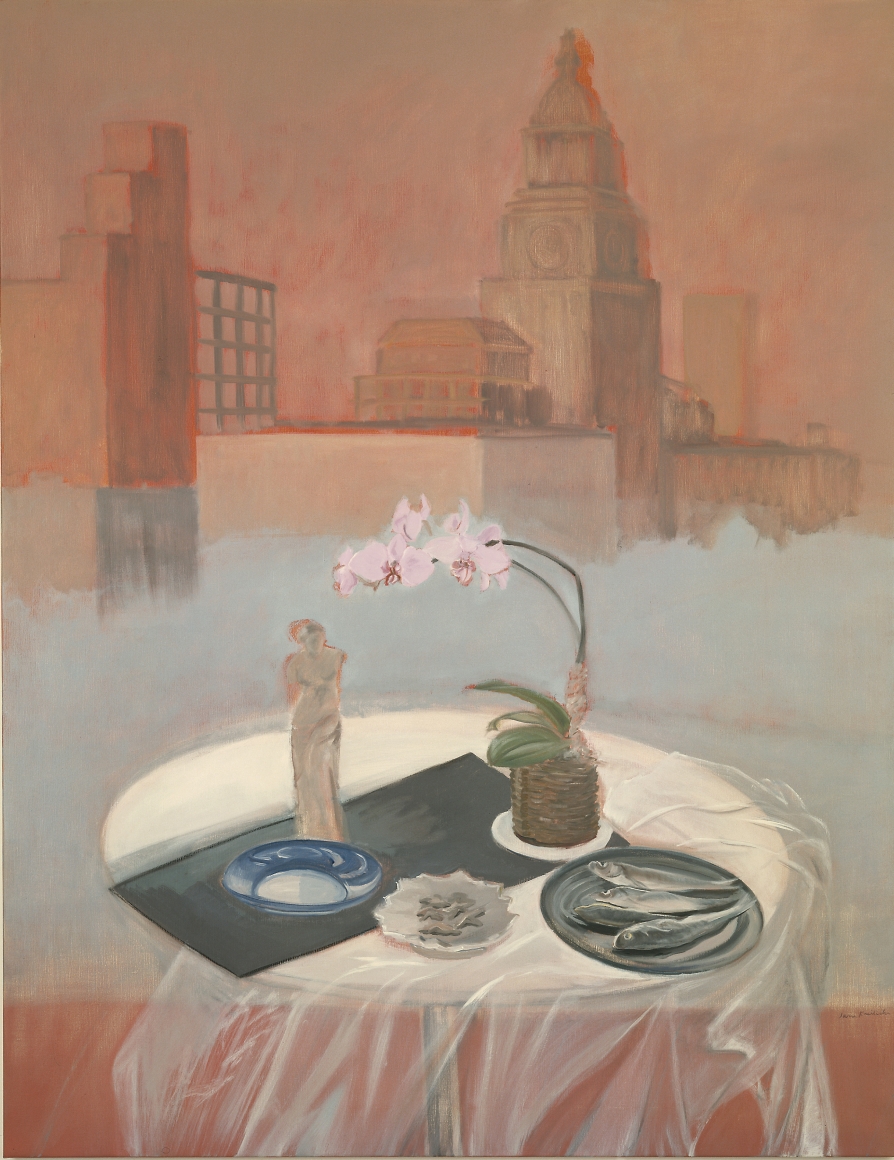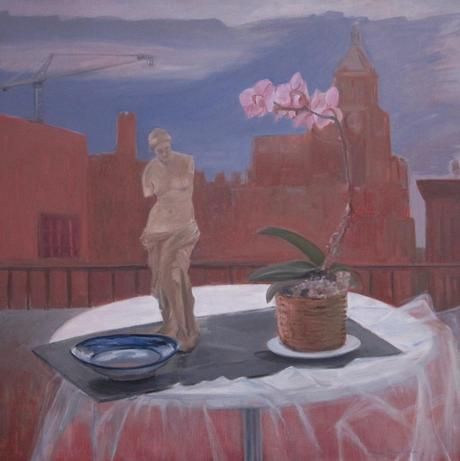Jane Freilicher's "Parts of a World" and "Still Life on a Balcony" in Comparison
In 1987, Jane Freilicher painted two oil-on-linen works of nearly the same still life composition against a city backdrop. One rendition, Parts of a World, is viewed from a high vantage point, painted in tones that indicate dusk setting on an ancient land. The other, Still Life on a Balcony, is practically eye-level with its objects, in a color palette that suggests dawn, yet also a vaguely vaporwave dystopia. To my knowledge, these two paintings were never exhibited in conjunction (although it would ease my mind if Tibor de Nagy would e-mail me back and clarify this for me). I am operating under an aesthetic assumption that Parts of a World preceded Still Life on a Balcony, an assumption that is based on my conception of order with regards to history and modernity, dreaming and waking up. It seems right to experience haziness prior to clarity.
The Soothsayer's Recompense (1913) by Giorgio de Chichiro. Courtesy of The Philadelphia Museum of Art.
They are vacant paintings, not unlike Giorgio de Chirico’s piazzas--shadowy, nondescript industrial buildings arise like monuments or temples in the background of a scene of objects which allude to an ancient past. The proportions don’t seem quite right. There’s something off, as if a hint toward lucidity while dreaming. There are no humans, although the table seems to have been set by someone and possibly for someone, if not purely for its setter. Who was it set for? There is evidence of them, humans. There must have been someone... although plates are set out as if for a guest, no chairs are available. There must have been someone? If not to sit, then, to set. The evidence of humans without their presence seems to place the paintings in an abandoned future scenario. And the objects selected for the composition--a small Venus de Milo statue, a pink orchid, a blue plate, a black mat, all on a simple white table with a gauze tablecloth--they were curated by somebody. These objects take on entirely new meanings with a subtle shift in context. For some reason, a plate of fish was removed in the interlude between the painting of Parts of a World and Still Life on a Balcony. The array of depicted objects and the painter are the only elements shared in two so similar, yet dramatically different paintings.
It seems somewhat blasphemous to mine for symbolic meaning in the work by a woman who has been quoted as saying, “My poet friends didn't influence me directly with their work ... there's a sympathetic vibration, a natural syntax — a lack of pomposity or heavy symbolism — and something to do with intimism, an intimate kind of expression.” I will still evaluate its symbolism because they are symbols of concepts which personally resonate with me and contain a breadth of associations, and I simply do not believe that symbolism can really be shunned. The selected objects seem to be able to embody temporal and environmental flexibility with a certain blend of feminine spirituality and sensuality. Their inherent fragmentation becomes apparent with the contextual shift.
Venus de Milo, who is famous for what she does not have, is revealed in the mystery of what she may lack. Her inadequacy is eternal. Her incompleteness has been replicated in a requiem by those who liked their women abstracted. Or occasionally, related to her abstraction. Venus is a ghost who has been memorialized long after death while her once-alive counterpart eroded into ancient soils. Venus is a small totem taking refuge under an orchid in Parts of a World, echoing the structure of a tiered skyscraper in the background. In Still Life on a Balcony, she stands at nearly the same height as the orchid. Venus becomes less of an homage to ancient mystery and more a spokeswoman for auto-demolition--the change in perspective translates Venus’s seemingly modest pose into uncomfortable exposure.
The orchid itself transforms from delicate intimacy to a challenging, assertive power. And the orchid, seemingly bought so recently from the florist, is in fact virtually immortal, if given proper attention. The orchid unites the Old World and the New. It is a revered, widely-known, eccentric plant, so ancient that it is not far-fetched to imagine that Venus tended to orchids until her arms popped off. Orchid hobbyists use the word “abortion” to describe a premature bud or flower drop, or a poorly developed organ. In complete health, it bends pointedly as if fragmented; asymmetry is as inherent to the orchid as it is to Venus. The sparseness, this seemingly lacking quality of the orchid is a floral departure from the lush arrangements Freilicher is more drawn to paint. Venus’s relationship to the orchid shifts between the paintings--where she once comfortably stood, demure under its petals in Parts of a World, she is its foil in Still Life on a Balcony. In Still Life, the orchid points skyward and Venus looks down. They are not so much together in symbiosis as they are presented side-by-side as sisters with similar postures. Yet while Venus exposes herself to the gaze of the viewer, the orchid confronts the crane in the distance, aggressively and boldly, like an aimed gun. Venus is resigned; this is not her war.
Loaves and Fishes (1972) by Jane Freilicher. Courtesy of Tibor de Nagy Gallery.
The removal of the fish between the paintings feels strangely alarming to me. Fish, who swam so long ago in ancient waters, in the great cosmic womb out of which humanity was birthed. They are primordial animals, symbols of spiritual understanding. The biblical connotations cannot be ignored--Freilicher herself had previously painted a marvelous table setting entitled “Loaves and Fishes” (1973), a spread which burst with florals. Jung viewed the fish as a symbol for the unconscious, for psychic happenings, for the mind swimming through an oceanic dream-state. To remove fish along with the hazy fog from the array is akin to stripping the painting of its dream-like ambience. Their removal rings like a harsh alarm clock in the morning, a call to awaken to reality.
In the morning, with the loss of the fish and the fog, a harsh metal barrier and a crane appear. The world is mechanized and under construction. Venus and the orchid are now prisoners to the urban environment, whereas previously they were structurally integrated. The transition is like from a drunken, nostalgic contentment of an evening to morning’s shocking hangover. Even the tablecloth appears to halt; where it once softly billowed, it is now stiff and hostile. The blue plate is rather precariously sitting at the edge of the table. I am anxious that it will tip over and shatter. The shift in time between the paintings somehow generates a shift in space, time and space inextricably related in considering setting.
Jane Freilicher was an artist who very actively engaged with the work of poets, particularly those who we identify today as the First Generation New School poets: Ashbery, O’Hara, Schuyler, Koch, the like. Jenni Quilter wrote of Freilicher in an essay for Poetry Magazine, “her images all have an accommodatory feel, as if she were making room for the poet, helping to stage their words rather than creating any kind of third mind.” Quilter asserts that Freilicher was more set designer than collaborator to the production of poetry in her circles. Not the co-starring leading lady, but the hand which set the scene and tone. The title Parts of a World is taken from a collection of poems by Wallace Stevens which contains the poem “Of Modern Poetry”. In considering the contrast of moments in time together with this shift’s impact on mental perception and Freilicher’s relationship to poetry, the first stanza of “Of Modern Poetry” may offer some guidance:
“The poem of the mind in the act of finding
What will suffice. It has not always had
To find: the scene was set; it repeated what
Was in the script.
Then the theatre was changed
To something else. Its past was a souvenir.”
Viewing Freilicher as the set designer and her paintings as the sets which establish tonality for poetic performance, the nuanced changes she implemented in a modified reproduction of her original still life significantly alter the tone of the “poems of the mind” which may occupy the space she carved. But (and this is what confounds me), why reproduce this still life with a different tone, if the works are not displayed side-by-side to illustrate the very concept of impact of composition and palette on tone, or conversely, how extensively a single place can vary depending on a viewer’s current mood? It’s almost as if she painted one version, decided it was not representative, and decided to paint one that was more accurate to her mental state and perception. It is even possible that Freilicher painted Parts of a World as a “souvenir” for wistfulness and later resigned herself to the quasi-sarcastic bleakness of Still Life on a Balcony. The theatre was changed, and so, the script.
Katherine Beaman




